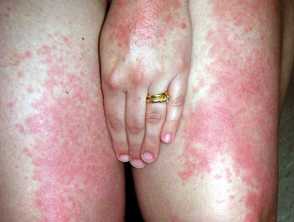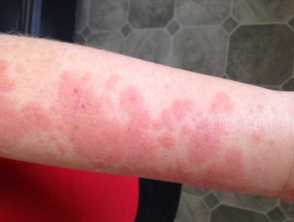What is polymorphic light eruption?
Polymorphic light eruption (PMLE) is a seasonal, acquired, idiopathic photodermatosis occurring in spring and early summer.
It is also known as polymorphous light eruption, sun allergy, sun poisoning, prurigo aestivalis, summer eruption/prurigo, or eczema solare. Juvenile spring eruption is a variant of PMLE.
Polymorphic light eruption
Who gets polymorphic light eruption?
- Presents predominately between 20–40 years of age.
- Four times more common in women than men.
- Presents in temperate climates and is more common where sun exposure is uncommon.
- Prevalence has been shown to be inversely related to latitude (highest in Scandinavia, the United Kingdom, and the northern United States; lowest in Australia).
- In northern Europe, it may affect 20–40% of women holidaying in the Mediterranean area, whereas in Australasian areas it is estimated to only affect between 1–5% of people.
- Reported to be more common at higher altitudes compared to sea level regions.
- Affects all races and all skin phototypes but higher prevalence in Fitzpatrick skin type 1.
Patients with PMLE can develop a tolerance during summer months.
What causes polymorphic light eruption?
There is a genetic susceptibility in 15–46% of cases where a positive family history is reported.
PMLE is a delayed hypersensitivity reaction in the skin to unknown endogenous cutaneous photo-induced antigens. This abnormal response to ultraviolet (UV) light means affected patients develop an inflammatory response to an endogenous photo-induced antigen. The following factors must be considered when determining pathogenesis and when implementing protective measures:
- It is primarily caused by either UVA (75–90%) or UVB light alone or UVA and UVB light concurrently
- It is rarely caused by visible light
- UVA can penetrate window glass and some sunscreens do not protect against it
- Some patients have reported a response to UVC from welding arcs.
UV radiation usually creates an immunosuppressive response in the skin, however, patients with PMLE may have a reduction in this normal response. In PMLE patients, UV radiation leads to an increased amount of CD4 and CD8 T lymphocytes, and an increased inflammatory response in the epidermis and dermis. The photo antigen that triggers this response is currently unknown.
Some patients experience PMLE during phototherapy, which is used to treat skin conditions such as psoriasis and dermatitis.
Because PMLE is more prevalent in women than men, it is hypothesized that there is a hormonal component to its pathogenesis. Estradiol may act as an inhibitor to the UV light immunosuppression which would normally aid in reducing hypersensitivity reactions.
What are the clinical features of polymorphic light eruption?
- Seasonal, occurring in spring and early summer and usually disappearing completely in winter.
- Winter occurrences likely due to solariums (tanning facilities) or a holiday to a sunnier climate.
- Onset: occurs within several hours to 1–2 days after exposure to sunlight and is usually intermittent.
- Duration: can last from days to weeks and resolves faster if further sun exposure is avoided.
- Recurrence: likelihood reduces as summer continues due to “hardening” of skin (see below).
As the name suggests, clinical features can vary — poly meaning “many”, morphic meaning “forms”. The morphology can include eruptions that are:
- Papular
- Eczematous (dry, red patches and plaques)
- Papulovesicular (small blisters)
- Urticarial
- Erythema multiforme-like (targetoid lesions).
The morphology is, however, always the same in one patient.
Distribution can include areas exposed to sunlight such as the arms, lower legs, V of the neck, and the chest. The dorsal hands and face are uncommon sites for PMLE possibly due to their chronic exposure to the sun and hardening of the skin. The eruption is usually symmetrically distributed in a patchy fashion and typically does not involve all of the exposed skin. It can be mildly to markedly pruritic and general malaise, headache, fever, and nausea can occur in rare cases.
PMLE persists for several days and can worsen if the affected skin is exposed to further sunlight before resolution of the previous eruption. It resolves without scarring.
Skin hardening effect
There is a phenomenon called the skin hardening effect where chronic exposure to sunlight leads to skin changes including increased melanin and thickening of the stratum corneum. These changes are thought to restore the skin’s normal immunosuppressive response to UV light and hence reducing or resolving PMLE over time. This can explain why it is uncommon to get PMLE in areas of the face or hands due to their chronic exposure to the sun compared to other areas of the body.
How do clinical features vary in differing types of skin?
PMLE can be seen in all races and all skin types. It is more common in people with lighter skin. In darker skin types, the most common morphology is grouped, pinhead-sized papules.
What are the complications of polymorphic light eruption?
- Emotional distress
- Anxiety and depression
- Avoidance of activities due to concern for flares with sun-exposure
- If sun avoiding, there is a risk of vitamin D deficiency
How is polymorphic light eruption diagnosed?
A clinical diagnosis of polymorphic light eruption can be made based on a history of a pruritic eruption occurring following sun exposure and previous episodes in spring or summer. Accurate diagnosis relies on the exclusion of other photosensitive conditions.
To exclude other photosensitive conditions a skin biopsy may be considered. The histopathology of PMLE is nonspecific, variable, and can include:
- Epidermal spongiosis
- Superficial and deep perivascular and peri-appendageal lymphohistiocytic infiltrate, often with scattered eosinophils and neutrophils.
- Significant papillary dermal oedema is common in more advanced cases.
Direct immunofluorescence is negative in PMLE.
Suitable investigations to determine the exclusion of cutaneous lupus erythematosus include full blood count; circulating antinuclear antibodies (ANA); extractable nuclear antigens (ENA); and direct immunofluorescence on histopathology.
Phototesting can be considered but is not carried out in all patients with PMLE.
- A provocative test in which UV radiation is used to confirm the diagnosis.
- 60% of patients yielding a positive eruption are clinically and histopathologically consistent with PMLE.
- The patient is exposed ideally to UVA (alternatively UVB) daily for 3–5 days to a small area of skin (such as the forearms or v of neck), which elicits an eruption.
What is the differential diagnosis for polymorphic light eruption?
- Lupus erythematosus
- Porphyria
- Solar urticaria
- Jessner lymphocytic infiltrate
- Photoaggravated atopic dermatitis
- Drug-induced photosensitivity
- Seborrheic dermatitis
What is the treatment for polymorphic light eruption?
General measures
- Broad-spectrum 50+ SPF UVA/UVB sunscreen
- Sun protective clothing
- Avoid sunlight, choose shaded areas if outdoors and sit away from windows
Specific measures
- Potent topical corticosteroids such as betamethasone dipropionate 0.05% or mometasone 0.1% ointment for the body and weaker topical corticosteroids for the face such as hydrocortisone 1% ointment.
- Short courses of oral corticosteroids — oral prednisolone 0.5–1mg/kg over 1–2 weeks during a flare, or during vacations when there is increased sun exposure.
- Phototherapy — UVB or UVA in early spring to induce “hardening”, may need topical or oral steroids first to prevent a flare.
- Hydroxychloroquine 200mg daily or twice daily through spring and summer.
- Topical calcipotriol may be useful as prophylaxis prior to sun exposure.
- Afamelanotide
- Nicotinamide — typically given 2–4 weeks prior to usual time of year PMLE is provoked; 1–3 grams per day (in divided doses) have been used.
- If severe, systemic immunosuppressants such as azathioprine or ciclosporin (cyclosporine)
What is the outcome for polymorphic light eruption?
PMLE may be lifelong although 60% of people see improvement or resolution over 15 years and 75% of people in 30 years.
The eruption can appear within hours of sun exposure and last for days. It can worsen with repeated exposure to sunlight before the eruption has resolved. It has been noted that PMLE appears to be less frequent and severe in women after menopause.

